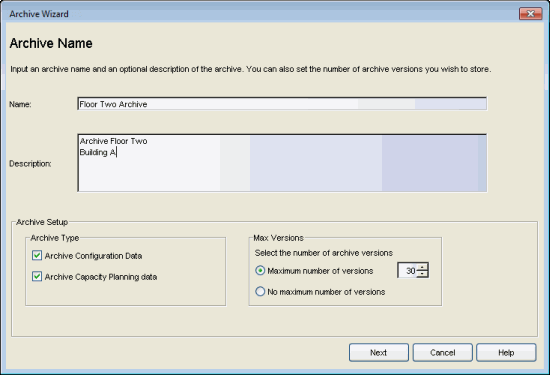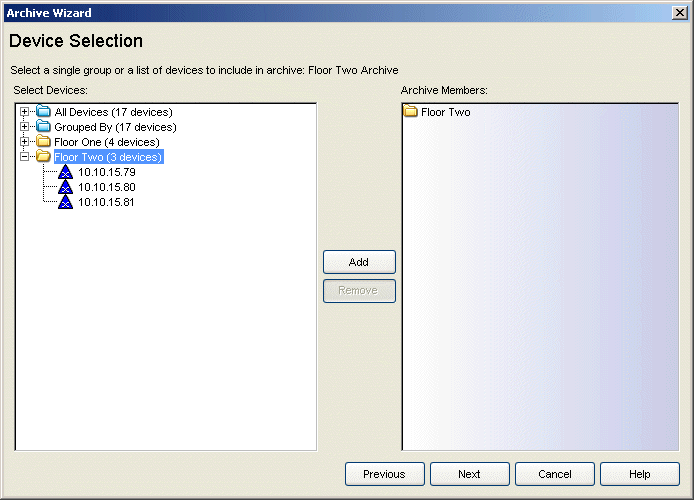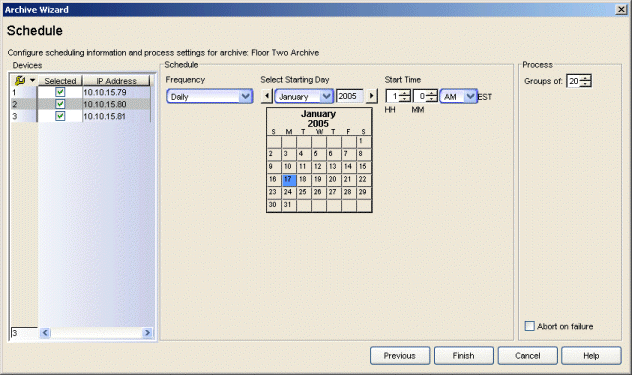Use the Archive Wizard to archive device configuration data and/or capacity planning data. Archiving device configuration data lets you create archives (backup copies) of your network devices' configurations that can be restored to the devices at a later date, if needed. Archiving capacity planning data lets you store port and FRU information for use by the Capacity Planning tool to generate reports. You can create an archive that saves both configuration data and capacity planning data, or you can create an archive that targets one type of data or the other.
You can perform archives on a single device, multiple devices, or on an entire device group. Because it is useful to archive data on a regular basis, Inventory Manager lets you schedule archives to be performed at a future time, and/or on a routine basis. Once you have configured an archive's parameters, you can use that archive on a repeated basis to save new versions of the desired data. For example, you may want to create an archive that saves your device configurations on a weekly basis, and also create an archive that saves only capacity planning information on a daily basis to monitor what is changing on the network.
| TIP: | You can set up an e-mail notification based on the event log message that is
generated when a configuration change is detected. When the
current archive differs from the previously saved archive, Inventory Manager
generates an event log message. Using the NetSight Console Alarms Manager you
can create an alarm that monitors the Inventory Log for the text "Configurations
Are Different" and define an e-mail to be executed as the specific alarm action. |
|---|
Once an archive operation has been created, it is listed by name in the
left-panel Archive Mgmt tab under the
Archives folder. Below the archive name are the archive versions, displayed by the date
and time the version was performed. Under the versions are the individual
configurations, listed by
IP address of the device whose data was saved. Each configuration displays an
icon that identifies the type of data being saved:
![]() device configuration data,
device configuration data, ![]() capacity planning
data,
capacity planning
data, ![]() both device configuration and capacity planning
data.
both device configuration and capacity planning
data.
To access the wizard, select Tools > Wizards > Archive Wizard from the menu bar or click
![]() on the toolbar.
You must have a TFTP or FTP server running to create an archive. For more
information, see
TFTP Server Setup or FTP Server Setup.
on the toolbar.
You must have a TFTP or FTP server running to create an archive. For more
information, see
TFTP Server Setup or FTP Server Setup.
| NOTE: | If the device is an X-Pedition router, be aware that when archiving
device configuration data, the router's Startup configuration
file is saved. |
|---|
Archive Name Window
Use this window to name and configure the archive.
Click the Graphic for more information.

Archive Setup
- Archive Type
- Select the appropriate checkbox for the type of data you wish to
archive:
- Archive Configuration Data - Create archives (backup copies) of your devices' configurations that can be restored to the devices at a later date, if needed.
- Archive Capacity Planning data - Create archives of port and FRU information to be used by the Capacity Planning tool to generate reports.
- Max Versions
- If desired, specify the maximum number of versions you would like saved for this archive. This allows you to limit the number of versions saved for each archive. Once the maximum number is reached, older versions are automatically deleted. Otherwise, you can select to not have a maximum number of archive versions.
Device Selection Window
Use this window to select the devices to include in the archive.
| NOTE: | If you select multiple tree nodes representing the same device but with
varying SNMP contexts, an archive save will be performed for each context.
However, the context must provide access to the MIBs required for the archive
save operation or the archive for that context will fail. It is recommended that
you perform the archive operation on the device with the default context (switch
mode.) |
|---|
Click the graphic for more information.

- Select Devices
- This panel displays your current devices as they are listed in the left-panel Network Elements tab. Expand the folders and select the single device, multiple devices (using the Control or Shift keys,) or a single device group that you want to include in the archive. Click the Add button to add the devices to the Archive Members list.
- Archive Members
- The devices you have selected are listed under Archive Members.
If you want to remove a member from the list, select the member and
click Remove.
TIP: If you open the Archive Wizard from a device or device group in the left-panel Network Elements tab, the selected device or device group will be automatically displayed under Archive Members.
- Add Button
- In the Devices tree, select the device(s) or device group you want to archive, and click Add to add it to the Archive Members list.
- Remove Button
- Select a device or device group in the Archive Members list, and click Remove to remove it from the list.
Schedule Window
Use this window to select devices, and configure scheduling information and process settings for the archive. You can schedule a one-time, daily, or weekly archive, or schedule the archive to be performed on server start-up.
Click the graphic for more information.

Devices
- Selected
- Use the checkboxes in this column to select or deselect specific devices to be archived. For example, if you selected a device group in the previous window, you can use these checkboxes to deselect individual devices in that group.
- IP Address
- The IP address of the device to be archived. Note that chassis that support Distributed Forwarding Engines (DFEs), such as the N-Series, display a single management IP even though there may be multiple DFE modules in the chassis.
Schedule
- Frequency
- Use the drop-down list to select the frequency with which you want the archive performed: Never, Now, Once, Daily, Weekly, or On Server Startup. The Never option lets you create an archive operation without actually performing it. The Now option lets you perform an immediate archive.
- Select Starting Day
- Use the drop-down list to select the month you want the archive to start. A calendar corresponding to the selected month is displayed. Select the desired starting day by clicking on the calendar. You can use the arrows on either side of the drop-down list to change the month, and change the year by entering a new year in the text field. (This field is grayed out if you have selected the Never or Now frequency.)
- Start Time
- Set the starting time for the operation and select AM or PM. (This field is grayed out if you have selected the Never or Now frequency.)
Process
- Groups of
- The archive will be performed in parallel (simultaneously) on the number of devices specified in the Groups of field. Set the value to 1 to have the operation performed serially, one device after another.
- Abort on failure
- Select the Abort on failure checkbox to stop the archive operation after a failure. This is useful if you are performing an archive operation on multiple devices and you want the operation to stop after a failure on a single device.
- Finish Button
- Creates the archive. The archive will be listed by name in the left-panel Archive Mgmt tab under the Archives folder, and performed according to its scheduled parameters. You can change the archive's parameters; see Editing an Archive for instructions.
For information on related tasks: